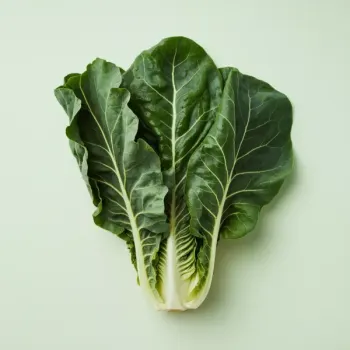Collard Greens are large, dark-colored, leafy vegetables with a mild, slightly bitter flavor, commonly used in Southern American cooking. Kale is a curly, textured leafy green with a peppery taste, often used raw in salads or cooked in dishes like soups and stews.

Collard greens are leafy vegetables from the Brassica family, known for their large, dark-colored edible leaves. They have a mild, slightly bitter flavor and are a staple in Southern American cooking.

Kale, also in the Brassica family, is a popular leafy green with curly, pebbly leaves. It comes in a few varieties, including curly and Lacinato, and has a slightly peppery and more intense flavor than collard greens.
Collard greens have a milder taste and a softer texture when cooked compared to kale's bold, slightly bitter flavor and sturdy texture. Collard greens are often simmered for a long time, while kale can be enjoyed both raw and cooked. Additionally, the nutrition profiles differ slightly, with kale generally having more vitamins and antioxidants.

Your ultimate Recipe Box, Meal Planner, and Cooking Class all in one
Collard greens are ideal for slow-cooked dishes like Southern-style stews, where they contribute a subtle, earthy flavor. They pair well with smoked meats and can withstand longer cooking times without becoming mushy. Kale holds up well in hearty soups like minestrone or Portuguese caldo verde. It adds a nutritious and colorful punch to the dish and can be added towards the end of the cooking process to retain its texture and vibrant hue.
Sautéed collard greens are delicious when cooked with onions and garlic until tender. They can handle strong flavors like bacon or ham hocks, which complement their natural bitterness. Kale sautés quickly and pairs well with ingredients like mushrooms, red pepper flakes, and a splash of vinegar or lemon juice to balance its peppery taste. It's great for a quick, nutritious side dish.
Young, tender collard greens can be used raw in salads but may require a massage to soften their tough texture. They're also a great gluten-free wrap alternative when used whole. Kale is a popular choice for raw salads, smoothies, and juices due to its nutritional profile. Massaging kale with a bit of oil and acid can help tenderize the leaves, making them easier to eat raw.
Collard greens can be turned into chips when baked with a light coating of oil and seasoning. They result in a chewier texture compared to kale and require a slightly longer baking time. Kale chips are a crunchy, healthy snack. They're made by baking kale pieces with oil and desired seasonings until crispy. Kale's natural texture makes it perfect for creating light, airy chips.
Both collard greens and kale are nutrient-dense foods high in vitamins A, C, and K.
| Nutrient | Kale ( per Cup ) | Collard Greens ( per Cup ) |
|---|---|---|
| Fat | 0.6g | 0.7g |
| Sodium | 25mg | 30mg |
| Calcium | 100mg | 266mg |
| Protein | 3g | 4g |
| Calories | 33 | 49 |
| Vitamin A | 0.5mg | 0.8mg |
| Vitamin C | 80mg | 35mg |
| Vitamin K | 547mcg | 858mcg |
| Carbohydrates | 6g | 9g |
Both are highly nutritious, but kale has a slight edge in terms of vitamins and antioxidants. The best choice depends on your personal nutrition goals and taste preference.
Yes, you can usually substitute kale for collard greens, especially in cooked dishes, but keep in mind that kale has a stronger flavor and cooks faster.
Collard greens can be tenderized by massaging them or cooking them for a longer period, especially in dishes like stews and braises.
Yes, both stems are edible, but they are tough and may require longer cooking times. Many people prefer to remove the stems, especially in raw preparations.
For collard greens, try a classic Southern stew with ham hocks. For kale, start with a simple kale salad with lemon dressing or kale chips.